Analysis of Leadership Change Management at Duke-NUS
VerifiedAdded on 2021/06/14
|20
|5874
|67
Report
AI Summary
This report provides a comprehensive analysis of leadership and change management within the context of Duke-NUS, an educational setting. It explores the concept of change, specifically addressing the changes implemented at Duke-NUS, and offers critical insights into the change process. The report delves into the implementation of team-based learning, examining its elements and application in an educational setting. Furthermore, it applies change management principles, analyzing the strategic partnership between the Government of Singapore and Johns Hopkins University, and the collaboration between NUS and Duke Med through Roger's Change Theory. The report concludes with a summarization of key findings and acknowledges research limitations, providing a thorough understanding of leadership and change management in a dynamic educational environment.
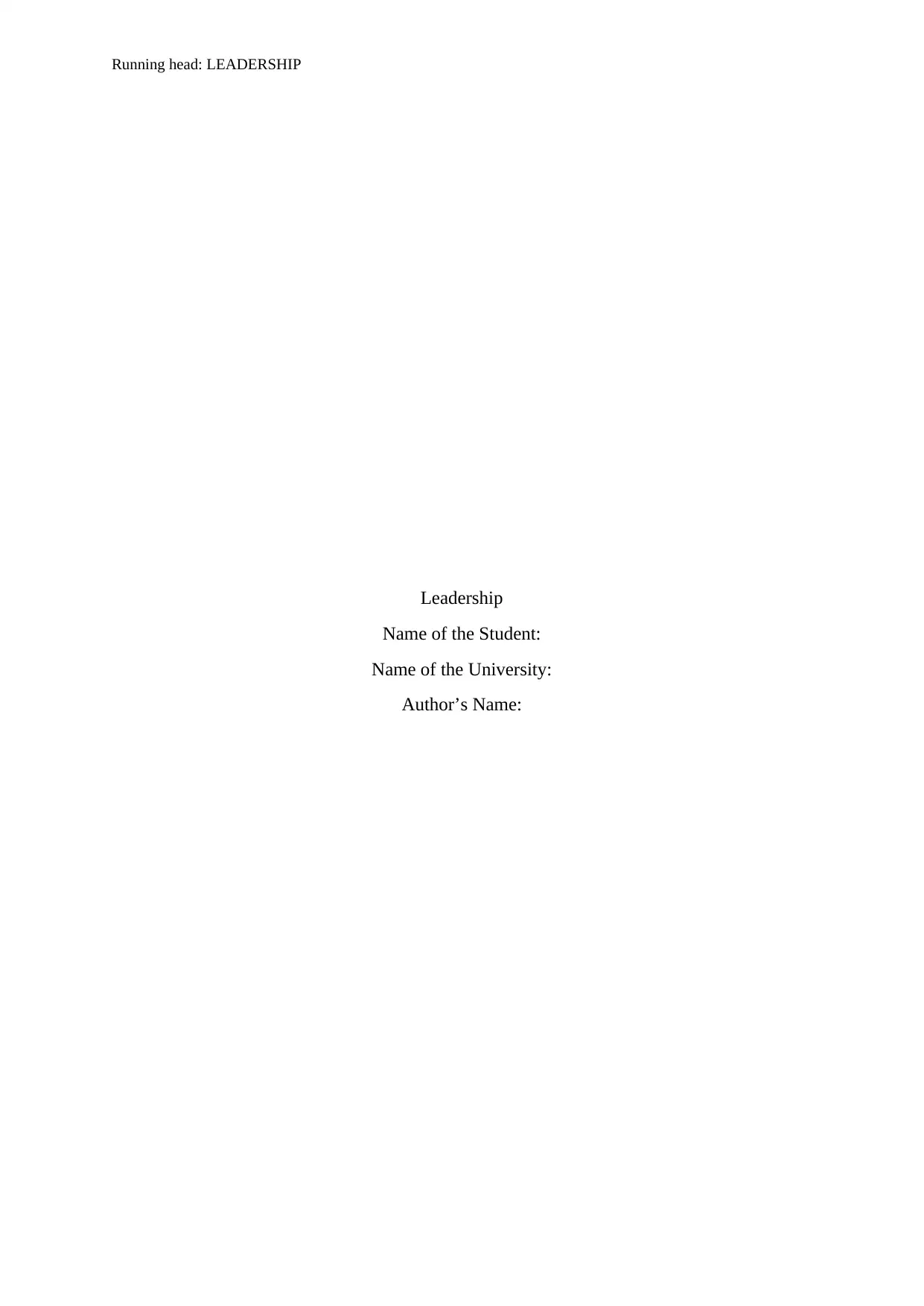
Running head: LEADERSHIP
Leadership
Name of the Student:
Name of the University:
Author’s Name:
Leadership
Name of the Student:
Name of the University:
Author’s Name:
Paraphrase This Document
Need a fresh take? Get an instant paraphrase of this document with our AI Paraphraser
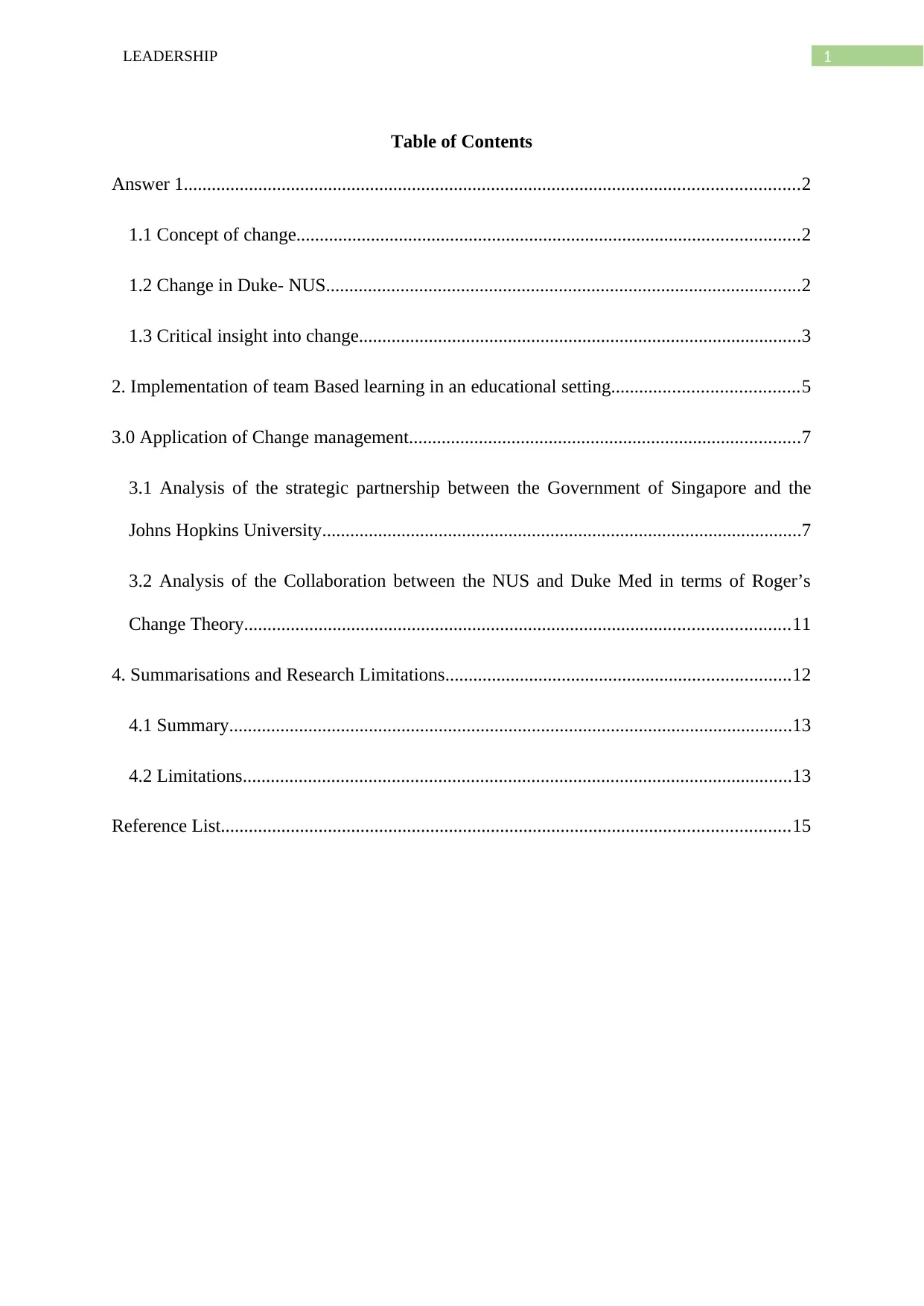
1LEADERSHIP
Table of Contents
Answer 1....................................................................................................................................2
1.1 Concept of change............................................................................................................2
1.2 Change in Duke- NUS......................................................................................................2
1.3 Critical insight into change...............................................................................................3
2. Implementation of team Based learning in an educational setting........................................5
3.0 Application of Change management....................................................................................7
3.1 Analysis of the strategic partnership between the Government of Singapore and the
Johns Hopkins University.......................................................................................................7
3.2 Analysis of the Collaboration between the NUS and Duke Med in terms of Roger’s
Change Theory.....................................................................................................................11
4. Summarisations and Research Limitations..........................................................................12
4.1 Summary.........................................................................................................................13
4.2 Limitations......................................................................................................................13
Reference List..........................................................................................................................15
Table of Contents
Answer 1....................................................................................................................................2
1.1 Concept of change............................................................................................................2
1.2 Change in Duke- NUS......................................................................................................2
1.3 Critical insight into change...............................................................................................3
2. Implementation of team Based learning in an educational setting........................................5
3.0 Application of Change management....................................................................................7
3.1 Analysis of the strategic partnership between the Government of Singapore and the
Johns Hopkins University.......................................................................................................7
3.2 Analysis of the Collaboration between the NUS and Duke Med in terms of Roger’s
Change Theory.....................................................................................................................11
4. Summarisations and Research Limitations..........................................................................12
4.1 Summary.........................................................................................................................13
4.2 Limitations......................................................................................................................13
Reference List..........................................................................................................................15
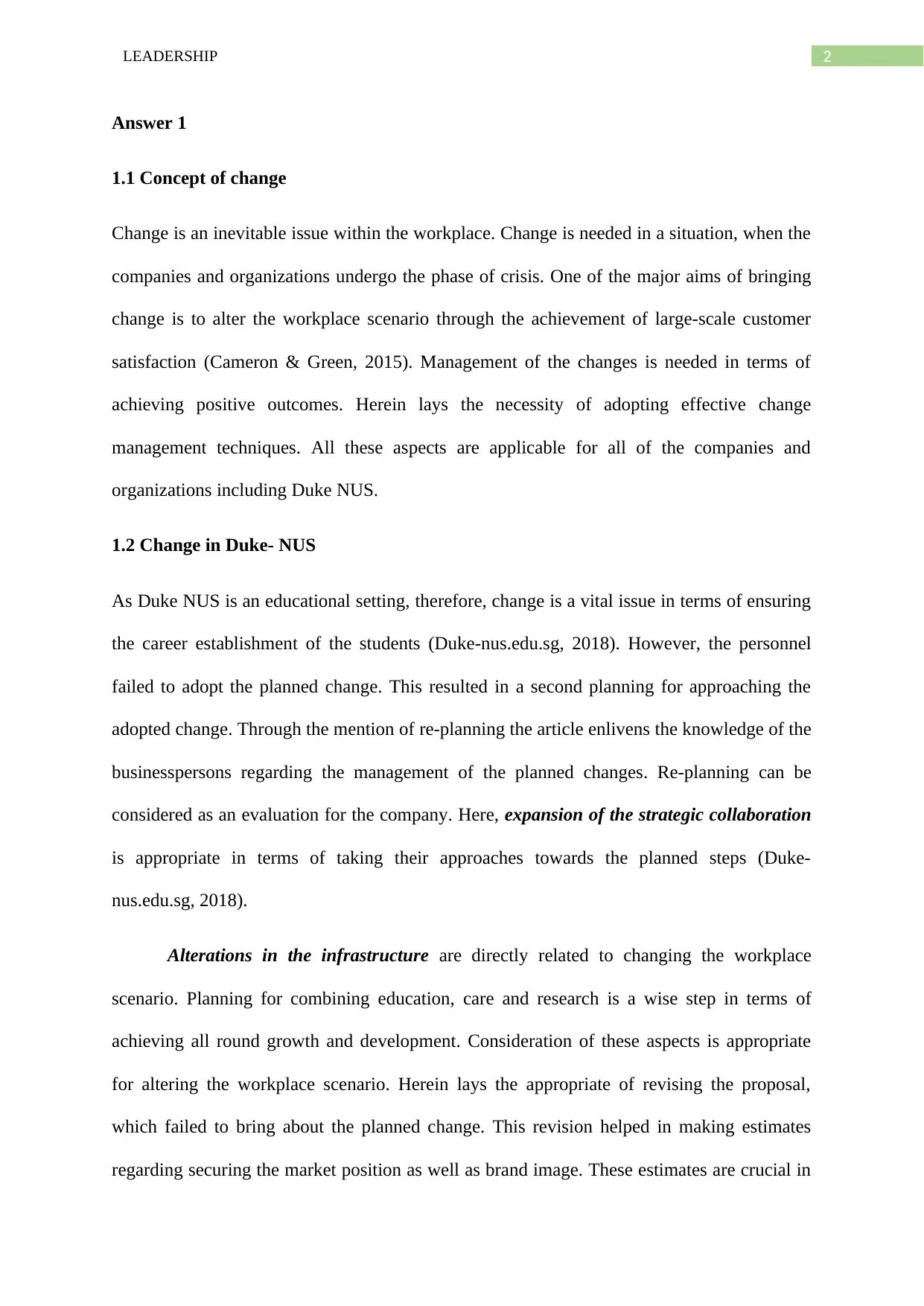
2LEADERSHIP
Answer 1
1.1 Concept of change
Change is an inevitable issue within the workplace. Change is needed in a situation, when the
companies and organizations undergo the phase of crisis. One of the major aims of bringing
change is to alter the workplace scenario through the achievement of large-scale customer
satisfaction (Cameron & Green, 2015). Management of the changes is needed in terms of
achieving positive outcomes. Herein lays the necessity of adopting effective change
management techniques. All these aspects are applicable for all of the companies and
organizations including Duke NUS.
1.2 Change in Duke- NUS
As Duke NUS is an educational setting, therefore, change is a vital issue in terms of ensuring
the career establishment of the students (Duke-nus.edu.sg, 2018). However, the personnel
failed to adopt the planned change. This resulted in a second planning for approaching the
adopted change. Through the mention of re-planning the article enlivens the knowledge of the
businesspersons regarding the management of the planned changes. Re-planning can be
considered as an evaluation for the company. Here, expansion of the strategic collaboration
is appropriate in terms of taking their approaches towards the planned steps (Duke-
nus.edu.sg, 2018).
Alterations in the infrastructure are directly related to changing the workplace
scenario. Planning for combining education, care and research is a wise step in terms of
achieving all round growth and development. Consideration of these aspects is appropriate
for altering the workplace scenario. Herein lays the appropriate of revising the proposal,
which failed to bring about the planned change. This revision helped in making estimates
regarding securing the market position as well as brand image. These estimates are crucial in
Answer 1
1.1 Concept of change
Change is an inevitable issue within the workplace. Change is needed in a situation, when the
companies and organizations undergo the phase of crisis. One of the major aims of bringing
change is to alter the workplace scenario through the achievement of large-scale customer
satisfaction (Cameron & Green, 2015). Management of the changes is needed in terms of
achieving positive outcomes. Herein lays the necessity of adopting effective change
management techniques. All these aspects are applicable for all of the companies and
organizations including Duke NUS.
1.2 Change in Duke- NUS
As Duke NUS is an educational setting, therefore, change is a vital issue in terms of ensuring
the career establishment of the students (Duke-nus.edu.sg, 2018). However, the personnel
failed to adopt the planned change. This resulted in a second planning for approaching the
adopted change. Through the mention of re-planning the article enlivens the knowledge of the
businesspersons regarding the management of the planned changes. Re-planning can be
considered as an evaluation for the company. Here, expansion of the strategic collaboration
is appropriate in terms of taking their approaches towards the planned steps (Duke-
nus.edu.sg, 2018).
Alterations in the infrastructure are directly related to changing the workplace
scenario. Planning for combining education, care and research is a wise step in terms of
achieving all round growth and development. Consideration of these aspects is appropriate
for altering the workplace scenario. Herein lays the appropriate of revising the proposal,
which failed to bring about the planned change. This revision helped in making estimates
regarding securing the market position as well as brand image. These estimates are crucial in
⊘ This is a preview!⊘
Do you want full access?
Subscribe today to unlock all pages.

Trusted by 1+ million students worldwide

3LEADERSHIP
terms of assessing the effectiveness, appropriateness and feasibility of the plans (Duke-
nus.edu.sg, 2018).
Considering the improper ratio of doctor-patient proved innovative in terms of adding
a new shade to the relation between the teacher and the students. Plans to use different
teaching methods were appropriate in this direction. The article proposes the teaching
methods used by the different branches of Duke NDS. This helps in evaluating the
appropriate method for changing the standards and quality of education. Releasing ranking of
the school services enhanced the awareness regarding the current strategic position. The
graduation, which took place on May 2011 left many questions regarding the planned change
and their management (Duke-nus.edu.sg, 2018). These questions catered to the collaboration
of the medical schools for enhancing the career of the students.
1.3 Critical insight into change
Change is an inevitable issue in the business context like the one in Duke NHS.
Changes are required for upgrading the standards and quality of the products and services.
Hesitation and dilemma are the most common reactions towards change. This is in case of the
employees, who attempt to stick to the traditional values. For this, the managers need to
undertake effective management techniques, so that the employees can be convinced for
adopting the change. Herein lays the appropriateness of theoretical considerations, which
enlivens the process of adopting change within the workplace scenario. One of the theories
can be Kotter’s eight step change model (Pollack & Pollack, 2015).
At the initial stage, awareness was created among the students, professors and staffs
regarding the need for change. Within this, the interest of the students was taken into
consideration for the provision of quality education. The next step was evaluation of the
approaches of the students. This evaluation helped in reviewing the effectiveness,
terms of assessing the effectiveness, appropriateness and feasibility of the plans (Duke-
nus.edu.sg, 2018).
Considering the improper ratio of doctor-patient proved innovative in terms of adding
a new shade to the relation between the teacher and the students. Plans to use different
teaching methods were appropriate in this direction. The article proposes the teaching
methods used by the different branches of Duke NDS. This helps in evaluating the
appropriate method for changing the standards and quality of education. Releasing ranking of
the school services enhanced the awareness regarding the current strategic position. The
graduation, which took place on May 2011 left many questions regarding the planned change
and their management (Duke-nus.edu.sg, 2018). These questions catered to the collaboration
of the medical schools for enhancing the career of the students.
1.3 Critical insight into change
Change is an inevitable issue in the business context like the one in Duke NHS.
Changes are required for upgrading the standards and quality of the products and services.
Hesitation and dilemma are the most common reactions towards change. This is in case of the
employees, who attempt to stick to the traditional values. For this, the managers need to
undertake effective management techniques, so that the employees can be convinced for
adopting the change. Herein lays the appropriateness of theoretical considerations, which
enlivens the process of adopting change within the workplace scenario. One of the theories
can be Kotter’s eight step change model (Pollack & Pollack, 2015).
At the initial stage, awareness was created among the students, professors and staffs
regarding the need for change. Within this, the interest of the students was taken into
consideration for the provision of quality education. The next step was evaluation of the
approaches of the students. This evaluation helped in reviewing the effectiveness,
Paraphrase This Document
Need a fresh take? Get an instant paraphrase of this document with our AI Paraphraser
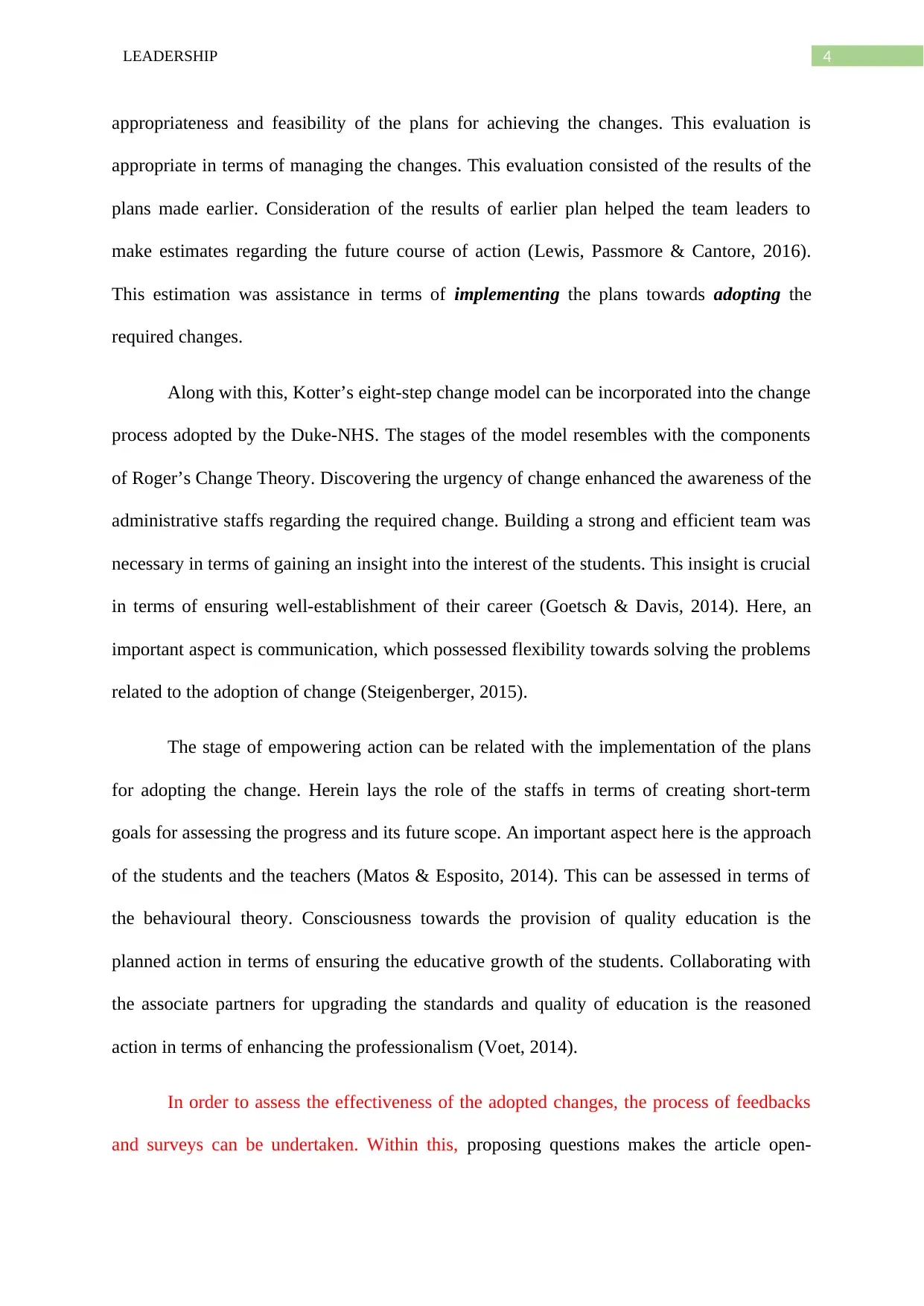
4LEADERSHIP
appropriateness and feasibility of the plans for achieving the changes. This evaluation is
appropriate in terms of managing the changes. This evaluation consisted of the results of the
plans made earlier. Consideration of the results of earlier plan helped the team leaders to
make estimates regarding the future course of action (Lewis, Passmore & Cantore, 2016).
This estimation was assistance in terms of implementing the plans towards adopting the
required changes.
Along with this, Kotter’s eight-step change model can be incorporated into the change
process adopted by the Duke-NHS. The stages of the model resembles with the components
of Roger’s Change Theory. Discovering the urgency of change enhanced the awareness of the
administrative staffs regarding the required change. Building a strong and efficient team was
necessary in terms of gaining an insight into the interest of the students. This insight is crucial
in terms of ensuring well-establishment of their career (Goetsch & Davis, 2014). Here, an
important aspect is communication, which possessed flexibility towards solving the problems
related to the adoption of change (Steigenberger, 2015).
The stage of empowering action can be related with the implementation of the plans
for adopting the change. Herein lays the role of the staffs in terms of creating short-term
goals for assessing the progress and its future scope. An important aspect here is the approach
of the students and the teachers (Matos & Esposito, 2014). This can be assessed in terms of
the behavioural theory. Consciousness towards the provision of quality education is the
planned action in terms of ensuring the educative growth of the students. Collaborating with
the associate partners for upgrading the standards and quality of education is the reasoned
action in terms of enhancing the professionalism (Voet, 2014).
In order to assess the effectiveness of the adopted changes, the process of feedbacks
and surveys can be undertaken. Within this, proposing questions makes the article open-
appropriateness and feasibility of the plans for achieving the changes. This evaluation is
appropriate in terms of managing the changes. This evaluation consisted of the results of the
plans made earlier. Consideration of the results of earlier plan helped the team leaders to
make estimates regarding the future course of action (Lewis, Passmore & Cantore, 2016).
This estimation was assistance in terms of implementing the plans towards adopting the
required changes.
Along with this, Kotter’s eight-step change model can be incorporated into the change
process adopted by the Duke-NHS. The stages of the model resembles with the components
of Roger’s Change Theory. Discovering the urgency of change enhanced the awareness of the
administrative staffs regarding the required change. Building a strong and efficient team was
necessary in terms of gaining an insight into the interest of the students. This insight is crucial
in terms of ensuring well-establishment of their career (Goetsch & Davis, 2014). Here, an
important aspect is communication, which possessed flexibility towards solving the problems
related to the adoption of change (Steigenberger, 2015).
The stage of empowering action can be related with the implementation of the plans
for adopting the change. Herein lays the role of the staffs in terms of creating short-term
goals for assessing the progress and its future scope. An important aspect here is the approach
of the students and the teachers (Matos & Esposito, 2014). This can be assessed in terms of
the behavioural theory. Consciousness towards the provision of quality education is the
planned action in terms of ensuring the educative growth of the students. Collaborating with
the associate partners for upgrading the standards and quality of education is the reasoned
action in terms of enhancing the professionalism (Voet, 2014).
In order to assess the effectiveness of the adopted changes, the process of feedbacks
and surveys can be undertaken. Within this, proposing questions makes the article open-
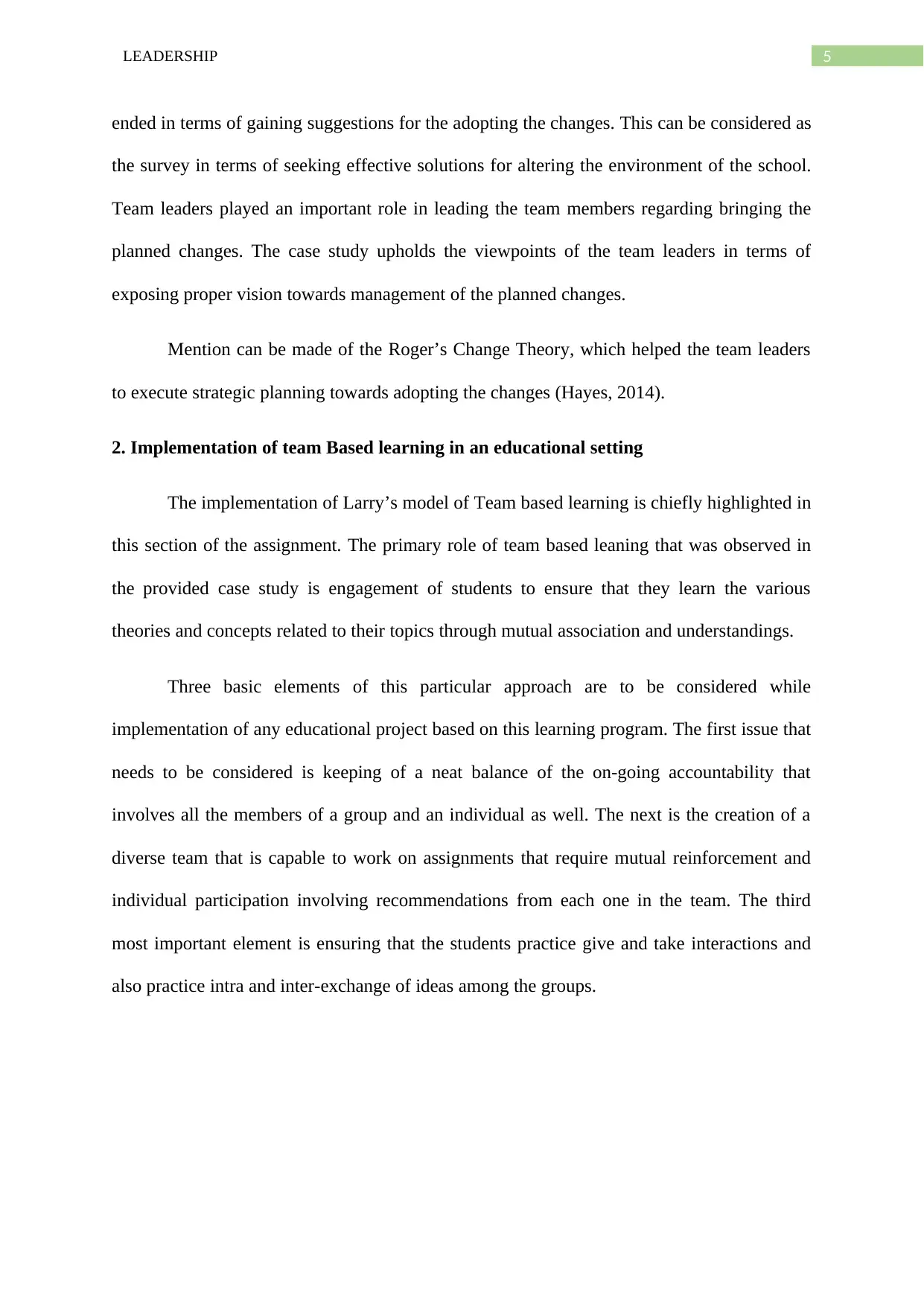
5LEADERSHIP
ended in terms of gaining suggestions for the adopting the changes. This can be considered as
the survey in terms of seeking effective solutions for altering the environment of the school.
Team leaders played an important role in leading the team members regarding bringing the
planned changes. The case study upholds the viewpoints of the team leaders in terms of
exposing proper vision towards management of the planned changes.
Mention can be made of the Roger’s Change Theory, which helped the team leaders
to execute strategic planning towards adopting the changes (Hayes, 2014).
2. Implementation of team Based learning in an educational setting
The implementation of Larry’s model of Team based learning is chiefly highlighted in
this section of the assignment. The primary role of team based leaning that was observed in
the provided case study is engagement of students to ensure that they learn the various
theories and concepts related to their topics through mutual association and understandings.
Three basic elements of this particular approach are to be considered while
implementation of any educational project based on this learning program. The first issue that
needs to be considered is keeping of a neat balance of the on-going accountability that
involves all the members of a group and an individual as well. The next is the creation of a
diverse team that is capable to work on assignments that require mutual reinforcement and
individual participation involving recommendations from each one in the team. The third
most important element is ensuring that the students practice give and take interactions and
also practice intra and inter-exchange of ideas among the groups.
ended in terms of gaining suggestions for the adopting the changes. This can be considered as
the survey in terms of seeking effective solutions for altering the environment of the school.
Team leaders played an important role in leading the team members regarding bringing the
planned changes. The case study upholds the viewpoints of the team leaders in terms of
exposing proper vision towards management of the planned changes.
Mention can be made of the Roger’s Change Theory, which helped the team leaders
to execute strategic planning towards adopting the changes (Hayes, 2014).
2. Implementation of team Based learning in an educational setting
The implementation of Larry’s model of Team based learning is chiefly highlighted in
this section of the assignment. The primary role of team based leaning that was observed in
the provided case study is engagement of students to ensure that they learn the various
theories and concepts related to their topics through mutual association and understandings.
Three basic elements of this particular approach are to be considered while
implementation of any educational project based on this learning program. The first issue that
needs to be considered is keeping of a neat balance of the on-going accountability that
involves all the members of a group and an individual as well. The next is the creation of a
diverse team that is capable to work on assignments that require mutual reinforcement and
individual participation involving recommendations from each one in the team. The third
most important element is ensuring that the students practice give and take interactions and
also practice intra and inter-exchange of ideas among the groups.
⊘ This is a preview!⊘
Do you want full access?
Subscribe today to unlock all pages.

Trusted by 1+ million students worldwide

6LEADERSHIP
Figure 2: Engagement of the students’ with the course concepts
(Source: Anderson & Sun, 2017)
In the case study on Duke NHS, team based learning had been implemented to ensure
the enhancement of the French speaking skills of students attending long language classes in
large group of approximately 85 students. As per Williams (2017), practice and orientation of
the learning theories is almost impossible in a conventional educational setting that involves
lot of students. I focused on creation of diverse groups keeping some key indicators in mind.
The first is bringing together of students which have perceived the equal level of speaking
ability. Secondly, the small groups were created of the students that had low motivation level.
On the other hand, the students with higher motivation level were provided with
comparatively bigger teams. Besides, the factor of how much exposure the students had
towards learning the outcome of the classes were also kept in mind.
The students pertaining to every group, initially answered the same questions on an
individual answer card. As per Chan et al. (2014), this is essential for mutual understanding.
Individual Work
Holding of small
group discussions
Discussion sessions
held between the
whole study section
Figure 2: Engagement of the students’ with the course concepts
(Source: Anderson & Sun, 2017)
In the case study on Duke NHS, team based learning had been implemented to ensure
the enhancement of the French speaking skills of students attending long language classes in
large group of approximately 85 students. As per Williams (2017), practice and orientation of
the learning theories is almost impossible in a conventional educational setting that involves
lot of students. I focused on creation of diverse groups keeping some key indicators in mind.
The first is bringing together of students which have perceived the equal level of speaking
ability. Secondly, the small groups were created of the students that had low motivation level.
On the other hand, the students with higher motivation level were provided with
comparatively bigger teams. Besides, the factor of how much exposure the students had
towards learning the outcome of the classes were also kept in mind.
The students pertaining to every group, initially answered the same questions on an
individual answer card. As per Chan et al. (2014), this is essential for mutual understanding.
Individual Work
Holding of small
group discussions
Discussion sessions
held between the
whole study section
Paraphrase This Document
Need a fresh take? Get an instant paraphrase of this document with our AI Paraphraser

7LEADERSHIP
Later the groups came into practice when the answers were negotiated in groups forming a
quiz scratch card. One group mark as allocated to each of the groups, based on the fewer
number of tries each of them took to answer each question. As per Weng et al. (2015), the
received marks also attributed to the individual progress of the students. The education
programs, followed the pattern of a likert scale styled question policy. As per Clerke et al.
(2017), this produces more precise answers. The question that where asked were basically
multiple choice questions that had five answers against each of them. In most cases there was
one correct answer. At times even two or none of the answers were correct. The identification
of the questions test the intelligence quotient of the groups.
The role of the teachers in this regard is also very crucial. They invested more than
half of their course time in speaking to the groups or listening to their queries or correcting
their conceptual flaws. As such, the teachers had to take up the extra burden of attending to
every team and solving their queries. However this is instrumental to ensuring the
understanding of the key concepts by the working groups. The teachers’ help enabled the
students to apply the practice the study materials comprehensively. One instance of a project
might be discussed. As per Dong and Goh (2015), this is of utmost importance for achieving
desired learning standard. Each of the groups were assigned with the tasks of reconstruction
of a small video conversation. The team members were supposed to confiscate the key words
and concept models that were taught to them on that respective day in the individual
presentation they were preparing. At the commencement of the activities, each of the groups
had to hand over solved worksheets to the teachers. The teachers worked as team mentors for
the project teams. Later, the most relevant and represented report gained most marks and each
of the students in the group hot highest marks for group contribution. Each of the teams were
marked in the same manner for this project. The group performance reflected in the marks
achieved by the individual students. At the end of the day, it might be confirmed that
Later the groups came into practice when the answers were negotiated in groups forming a
quiz scratch card. One group mark as allocated to each of the groups, based on the fewer
number of tries each of them took to answer each question. As per Weng et al. (2015), the
received marks also attributed to the individual progress of the students. The education
programs, followed the pattern of a likert scale styled question policy. As per Clerke et al.
(2017), this produces more precise answers. The question that where asked were basically
multiple choice questions that had five answers against each of them. In most cases there was
one correct answer. At times even two or none of the answers were correct. The identification
of the questions test the intelligence quotient of the groups.
The role of the teachers in this regard is also very crucial. They invested more than
half of their course time in speaking to the groups or listening to their queries or correcting
their conceptual flaws. As such, the teachers had to take up the extra burden of attending to
every team and solving their queries. However this is instrumental to ensuring the
understanding of the key concepts by the working groups. The teachers’ help enabled the
students to apply the practice the study materials comprehensively. One instance of a project
might be discussed. As per Dong and Goh (2015), this is of utmost importance for achieving
desired learning standard. Each of the groups were assigned with the tasks of reconstruction
of a small video conversation. The team members were supposed to confiscate the key words
and concept models that were taught to them on that respective day in the individual
presentation they were preparing. At the commencement of the activities, each of the groups
had to hand over solved worksheets to the teachers. The teachers worked as team mentors for
the project teams. Later, the most relevant and represented report gained most marks and each
of the students in the group hot highest marks for group contribution. Each of the teams were
marked in the same manner for this project. The group performance reflected in the marks
achieved by the individual students. At the end of the day, it might be confirmed that

8LEADERSHIP
ensuring individual accountability in a group activity is the ulterior motive of a team based
project (Ghasabeh, Soosay & Reaiche, 2015).
At the end of the project, the students were provided with feedback forms, required by
them to be filled up. The form contained the scope of mentioning the areas that they deemed
requiring of further improvement of techniques. They could opine about the pros and cons of
the marking criteria and the group segregation process for the project.
One of the essential principles in this case study is the application of code of ethics.
This is in terms of assessing the role of teachers and the students towards the exposure of
ethical approach. The principle is vital in terms of maintaining the honesty, integrity,
accountability, quality and trust. This maintenance strengthens the bondage between the
staffs and the clients. As students from diverse background have been selected, therefore,
code of ethics is crucial in terms of preserving the diversity. Risk assessment is also one of
the important components in terms of safeguarding the students and the teachers from the
potential risks (Haines, 2016). Conscious approach in this case is praiseworthy in terms of
ensuring the wellbeing of schools like Duke NHS as a whole.
3.0 Application of Change management
3.1 Analysis of the strategic partnership between the Government of Singapore and the
Johns Hopkins University
The eight yearlong strategic partnership between the government of Singapore and the
Johns Hopkins University ended in a coarse way with each party blaming the other for breach
of the contractual terms. The government raised a fund of $500 Singaporean Dollar that was
aimed at creating Singapore, the medical hub of Asia. As per Häggman‐Laitila, Mattila and
Melender (2016), this is one of the major investments made by the education department.
Primarily the failure and the contribution to the project from both ends might be evaluated in
ensuring individual accountability in a group activity is the ulterior motive of a team based
project (Ghasabeh, Soosay & Reaiche, 2015).
At the end of the project, the students were provided with feedback forms, required by
them to be filled up. The form contained the scope of mentioning the areas that they deemed
requiring of further improvement of techniques. They could opine about the pros and cons of
the marking criteria and the group segregation process for the project.
One of the essential principles in this case study is the application of code of ethics.
This is in terms of assessing the role of teachers and the students towards the exposure of
ethical approach. The principle is vital in terms of maintaining the honesty, integrity,
accountability, quality and trust. This maintenance strengthens the bondage between the
staffs and the clients. As students from diverse background have been selected, therefore,
code of ethics is crucial in terms of preserving the diversity. Risk assessment is also one of
the important components in terms of safeguarding the students and the teachers from the
potential risks (Haines, 2016). Conscious approach in this case is praiseworthy in terms of
ensuring the wellbeing of schools like Duke NHS as a whole.
3.0 Application of Change management
3.1 Analysis of the strategic partnership between the Government of Singapore and the
Johns Hopkins University
The eight yearlong strategic partnership between the government of Singapore and the
Johns Hopkins University ended in a coarse way with each party blaming the other for breach
of the contractual terms. The government raised a fund of $500 Singaporean Dollar that was
aimed at creating Singapore, the medical hub of Asia. As per Häggman‐Laitila, Mattila and
Melender (2016), this is one of the major investments made by the education department.
Primarily the failure and the contribution to the project from both ends might be evaluated in
⊘ This is a preview!⊘
Do you want full access?
Subscribe today to unlock all pages.

Trusted by 1+ million students worldwide
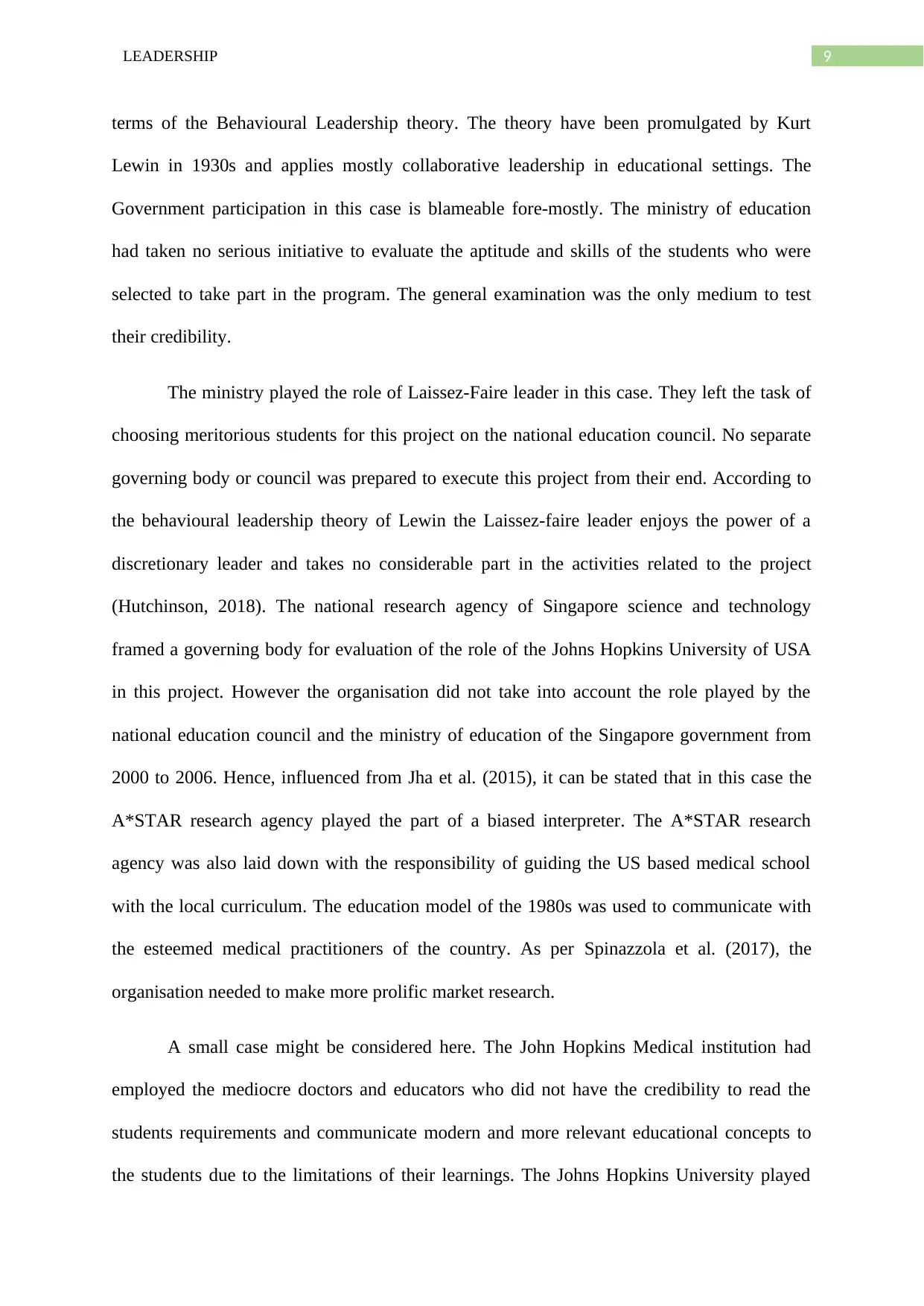
9LEADERSHIP
terms of the Behavioural Leadership theory. The theory have been promulgated by Kurt
Lewin in 1930s and applies mostly collaborative leadership in educational settings. The
Government participation in this case is blameable fore-mostly. The ministry of education
had taken no serious initiative to evaluate the aptitude and skills of the students who were
selected to take part in the program. The general examination was the only medium to test
their credibility.
The ministry played the role of Laissez-Faire leader in this case. They left the task of
choosing meritorious students for this project on the national education council. No separate
governing body or council was prepared to execute this project from their end. According to
the behavioural leadership theory of Lewin the Laissez-faire leader enjoys the power of a
discretionary leader and takes no considerable part in the activities related to the project
(Hutchinson, 2018). The national research agency of Singapore science and technology
framed a governing body for evaluation of the role of the Johns Hopkins University of USA
in this project. However the organisation did not take into account the role played by the
national education council and the ministry of education of the Singapore government from
2000 to 2006. Hence, influenced from Jha et al. (2015), it can be stated that in this case the
A*STAR research agency played the part of a biased interpreter. The A*STAR research
agency was also laid down with the responsibility of guiding the US based medical school
with the local curriculum. The education model of the 1980s was used to communicate with
the esteemed medical practitioners of the country. As per Spinazzola et al. (2017), the
organisation needed to make more prolific market research.
A small case might be considered here. The John Hopkins Medical institution had
employed the mediocre doctors and educators who did not have the credibility to read the
students requirements and communicate modern and more relevant educational concepts to
the students due to the limitations of their learnings. The Johns Hopkins University played
terms of the Behavioural Leadership theory. The theory have been promulgated by Kurt
Lewin in 1930s and applies mostly collaborative leadership in educational settings. The
Government participation in this case is blameable fore-mostly. The ministry of education
had taken no serious initiative to evaluate the aptitude and skills of the students who were
selected to take part in the program. The general examination was the only medium to test
their credibility.
The ministry played the role of Laissez-Faire leader in this case. They left the task of
choosing meritorious students for this project on the national education council. No separate
governing body or council was prepared to execute this project from their end. According to
the behavioural leadership theory of Lewin the Laissez-faire leader enjoys the power of a
discretionary leader and takes no considerable part in the activities related to the project
(Hutchinson, 2018). The national research agency of Singapore science and technology
framed a governing body for evaluation of the role of the Johns Hopkins University of USA
in this project. However the organisation did not take into account the role played by the
national education council and the ministry of education of the Singapore government from
2000 to 2006. Hence, influenced from Jha et al. (2015), it can be stated that in this case the
A*STAR research agency played the part of a biased interpreter. The A*STAR research
agency was also laid down with the responsibility of guiding the US based medical school
with the local curriculum. The education model of the 1980s was used to communicate with
the esteemed medical practitioners of the country. As per Spinazzola et al. (2017), the
organisation needed to make more prolific market research.
A small case might be considered here. The John Hopkins Medical institution had
employed the mediocre doctors and educators who did not have the credibility to read the
students requirements and communicate modern and more relevant educational concepts to
the students due to the limitations of their learnings. The Johns Hopkins University played
Paraphrase This Document
Need a fresh take? Get an instant paraphrase of this document with our AI Paraphraser

10LEADERSHIP
the role of the Democratic leader in this case. They had employed the groups of doctors for
their distance learning venture at Singapore University as an autonomous body that could
exercise their own discretion and innovation. They did not have adequate inputs required to
take the organisational decisions. As revealed later form the survey of the A*STAR agency,
the doctors employed by the US based university did not relate to their peers in America.
They did not consult the University of Singapore’s communicators in a proper way. As an
outcome, the students did not receive the necessary feed from them. Later this caused
disillusionment among them (Koffi & Fawcett, 2016). According to Lewin, the cases which
involves lot of ideas and incorporates large number of heads are not ideal for the democratic
leadership. Hence this false step taken by the teachers of the Johns Hopkins University in this
case proved fatal for this project.
Figure 2: Components of the Rogers Change Theory
(Source: Wong, 2015, p.276)
On discovering tis, the invigilators of the Singaporean university did not take any
action against this. They proclaimed that it was unnecessary to invest behind this faulty
Rogers
Change
Theory
awareness
implementation
adoptionEvaluation
interest
the role of the Democratic leader in this case. They had employed the groups of doctors for
their distance learning venture at Singapore University as an autonomous body that could
exercise their own discretion and innovation. They did not have adequate inputs required to
take the organisational decisions. As revealed later form the survey of the A*STAR agency,
the doctors employed by the US based university did not relate to their peers in America.
They did not consult the University of Singapore’s communicators in a proper way. As an
outcome, the students did not receive the necessary feed from them. Later this caused
disillusionment among them (Koffi & Fawcett, 2016). According to Lewin, the cases which
involves lot of ideas and incorporates large number of heads are not ideal for the democratic
leadership. Hence this false step taken by the teachers of the Johns Hopkins University in this
case proved fatal for this project.
Figure 2: Components of the Rogers Change Theory
(Source: Wong, 2015, p.276)
On discovering tis, the invigilators of the Singaporean university did not take any
action against this. They proclaimed that it was unnecessary to invest behind this faulty
Rogers
Change
Theory
awareness
implementation
adoptionEvaluation
interest
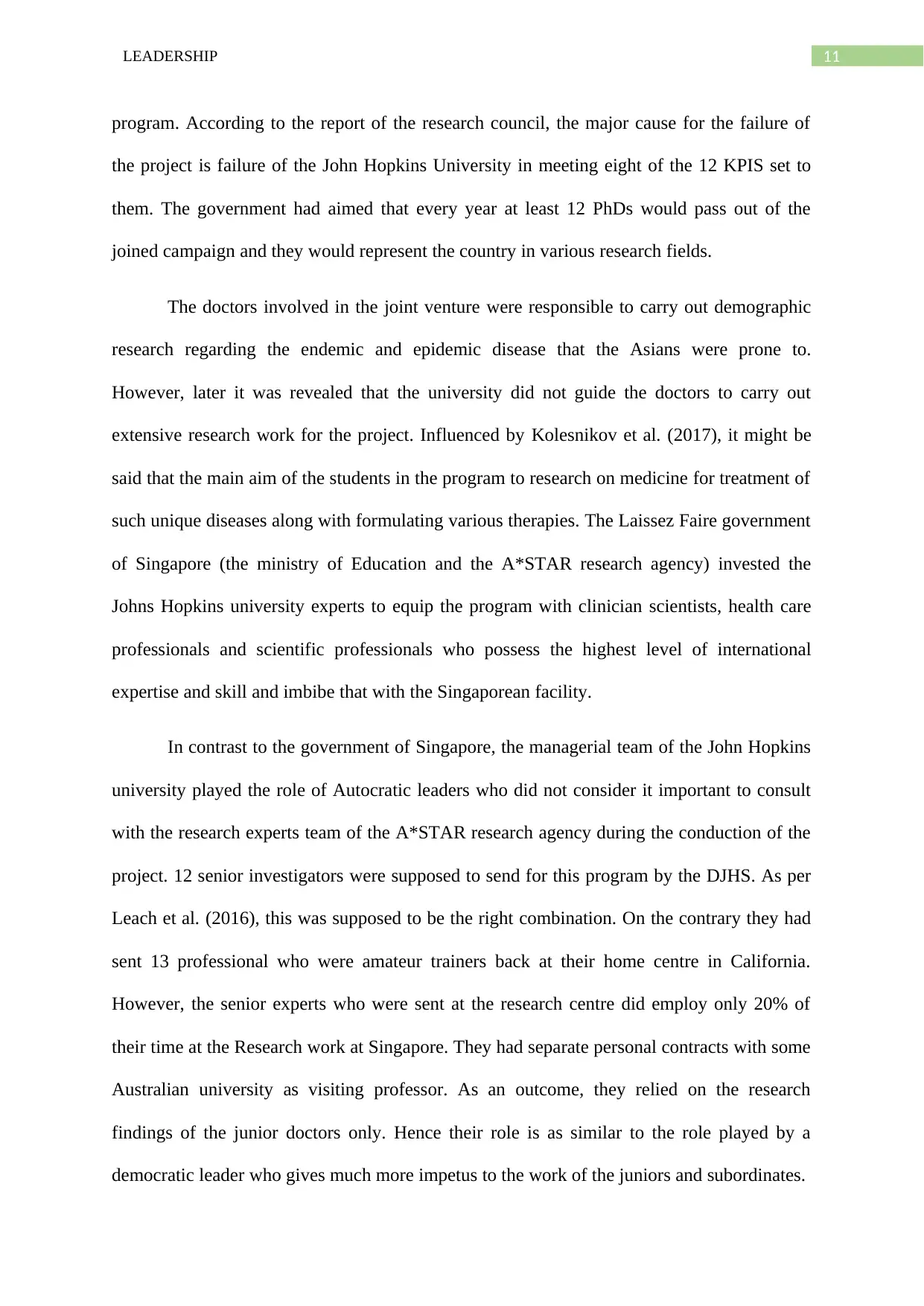
11LEADERSHIP
program. According to the report of the research council, the major cause for the failure of
the project is failure of the John Hopkins University in meeting eight of the 12 KPIS set to
them. The government had aimed that every year at least 12 PhDs would pass out of the
joined campaign and they would represent the country in various research fields.
The doctors involved in the joint venture were responsible to carry out demographic
research regarding the endemic and epidemic disease that the Asians were prone to.
However, later it was revealed that the university did not guide the doctors to carry out
extensive research work for the project. Influenced by Kolesnikov et al. (2017), it might be
said that the main aim of the students in the program to research on medicine for treatment of
such unique diseases along with formulating various therapies. The Laissez Faire government
of Singapore (the ministry of Education and the A*STAR research agency) invested the
Johns Hopkins university experts to equip the program with clinician scientists, health care
professionals and scientific professionals who possess the highest level of international
expertise and skill and imbibe that with the Singaporean facility.
In contrast to the government of Singapore, the managerial team of the John Hopkins
university played the role of Autocratic leaders who did not consider it important to consult
with the research experts team of the A*STAR research agency during the conduction of the
project. 12 senior investigators were supposed to send for this program by the DJHS. As per
Leach et al. (2016), this was supposed to be the right combination. On the contrary they had
sent 13 professional who were amateur trainers back at their home centre in California.
However, the senior experts who were sent at the research centre did employ only 20% of
their time at the Research work at Singapore. They had separate personal contracts with some
Australian university as visiting professor. As an outcome, they relied on the research
findings of the junior doctors only. Hence their role is as similar to the role played by a
democratic leader who gives much more impetus to the work of the juniors and subordinates.
program. According to the report of the research council, the major cause for the failure of
the project is failure of the John Hopkins University in meeting eight of the 12 KPIS set to
them. The government had aimed that every year at least 12 PhDs would pass out of the
joined campaign and they would represent the country in various research fields.
The doctors involved in the joint venture were responsible to carry out demographic
research regarding the endemic and epidemic disease that the Asians were prone to.
However, later it was revealed that the university did not guide the doctors to carry out
extensive research work for the project. Influenced by Kolesnikov et al. (2017), it might be
said that the main aim of the students in the program to research on medicine for treatment of
such unique diseases along with formulating various therapies. The Laissez Faire government
of Singapore (the ministry of Education and the A*STAR research agency) invested the
Johns Hopkins university experts to equip the program with clinician scientists, health care
professionals and scientific professionals who possess the highest level of international
expertise and skill and imbibe that with the Singaporean facility.
In contrast to the government of Singapore, the managerial team of the John Hopkins
university played the role of Autocratic leaders who did not consider it important to consult
with the research experts team of the A*STAR research agency during the conduction of the
project. 12 senior investigators were supposed to send for this program by the DJHS. As per
Leach et al. (2016), this was supposed to be the right combination. On the contrary they had
sent 13 professional who were amateur trainers back at their home centre in California.
However, the senior experts who were sent at the research centre did employ only 20% of
their time at the Research work at Singapore. They had separate personal contracts with some
Australian university as visiting professor. As an outcome, they relied on the research
findings of the junior doctors only. Hence their role is as similar to the role played by a
democratic leader who gives much more impetus to the work of the juniors and subordinates.
⊘ This is a preview!⊘
Do you want full access?
Subscribe today to unlock all pages.

Trusted by 1+ million students worldwide
1 out of 20
Related Documents
Your All-in-One AI-Powered Toolkit for Academic Success.
+13062052269
info@desklib.com
Available 24*7 on WhatsApp / Email
![[object Object]](/_next/static/media/star-bottom.7253800d.svg)
Unlock your academic potential
Copyright © 2020–2025 A2Z Services. All Rights Reserved. Developed and managed by ZUCOL.



